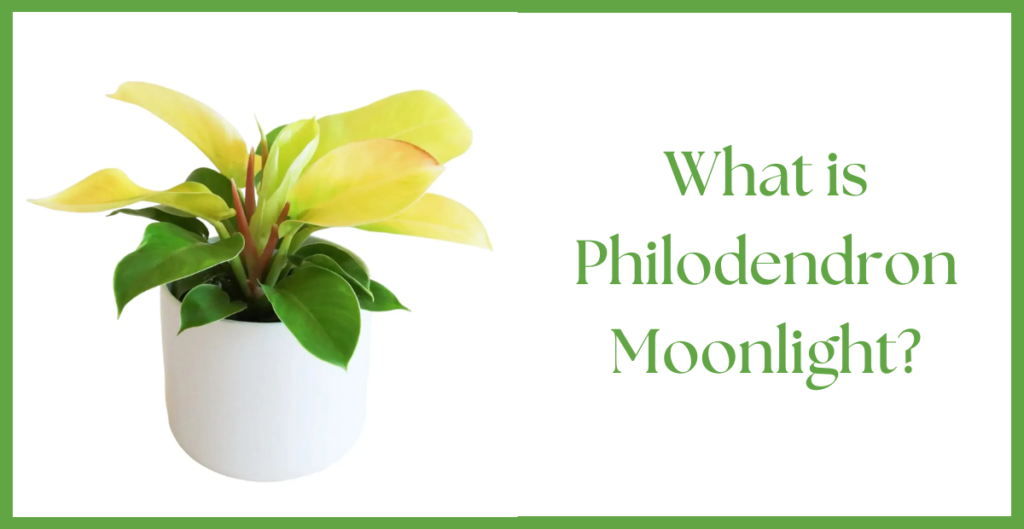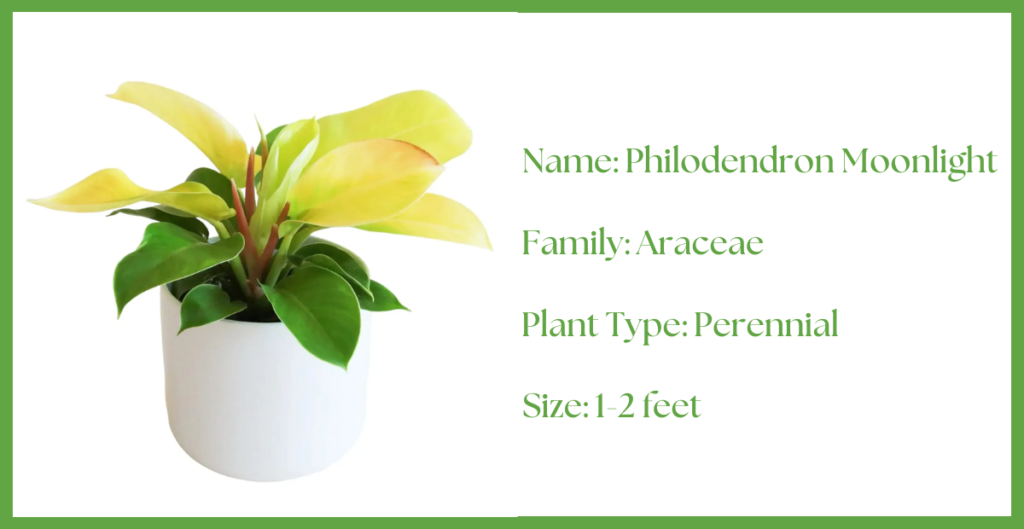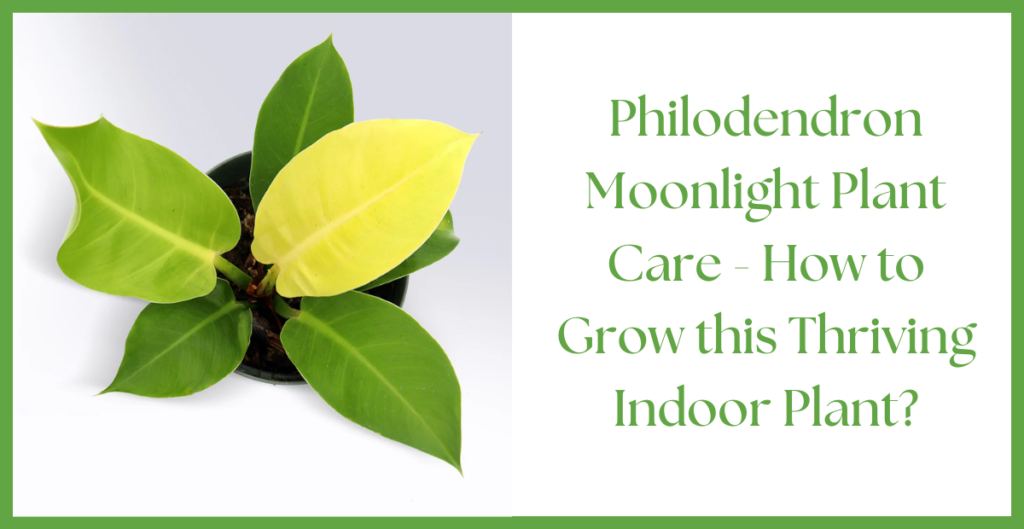Philodendron Moonlight is a vibrant and eye catching tropical houseplant known for its neon-yellow foliage that matures into a rich green. With its easy care nature and striking appearance, this plant is a favorite among both beginners and experienced plant lovers. If you’re looking to add a pop of color to your indoor space, Philodendron Moonlight is a fantastic choice!
What is Philodendron Moonlight?

Philodendron Moonlight is a hybrid species from the Araceae family. Unlike trailing philodendrons, it has a self heading growth habit, meaning it grows upright from a central stem. Its new leaves emerge in a bright yellow green hue before transitioning into deep green, making it a stunning addition to any home or office.
Quick Facts About Philodendron Moonlight

- Common Name: Philodendron Moonlight, Lime Philodendron
- Botanical Name: Philodendron ‘Moonlight’
- Family: Araceae
- Plant Type: Perennial, Tropical Houseplant
- Mature Size: 1-2 feet tall and wide
- Sun Exposure: Bright, Indirect Light
- Soil Type: Moist, Loamy, Well-Drained
- Soil pH: Acidic
- Native Area: Central and South America
- Toxicity: Toxic to pets and humans if ingested
Read more How to Plant Lucky Bamboo in Soil?
How to Care for Philodendron Moonlight
1. Light Requirements
Philodendron Moonlight thrives in bright, indirect light. Positioning it close to an east-facing window or at a slight distance from a south or west facing window ensures optimal growth. Too much direct sunlight can scorch the leaves, while too little light may cause the foliage to turn darker and slow its growth.
2. Best Soil Mix
To ensure optimal growth, use a nutrient rich, well draining potting mix for your Moonlight Philodendron. A good blend includes:
- Peat moss or coconut coir (moisture retention)
- Perlite or pumice (aeration and drainage)
- A small amount of organic compost (nutrient boost)
This combination keeps the soil airy while retaining the right amount of moisture.
3. Watering Schedule
Philodendron Moonlight prefers evenly moist soil but should not sit in standing water. Here’s a simple watering guide:
- Spring & Summer: Ensure the top inch of soil is dry before watering.
- Fall & Winter: Allow the soil to dry out more between waterings and reduce the frequency accordingly.
- Always empty the saucer under the pot to prevent root rot.
4. Temperature & Humidity Needs
This tropical plant flourishes in temperatures ranging from 65°F (18°C) to 80°F (27°C). While it adapts to average indoor humidity, it prefers humidity levels around 60-70%.
Ways to Increase Humidity:
- Use a humidifier near the plant.
- Group it with other tropical plants.
- Position a tray filled with pebbles and water beneath the plant.
5. Fertilizing Routine, Common Problems & Solutions
To encourage lush growth, fertilize once a month during spring and summer using a balanced liquid houseplant fertilizer diluted to half strength. Refrain from fertilizing during fall and winter as the plant’s growth slows.
6. Pruning & Maintenance
Philodendron Moonlight doesn’t need frequent pruning, but removing yellow or damaged leaves helps maintain its health. If the plant becomes too wide, trimming a few leaves selectively can help maintain its compact and neat appearance.
Read more about How To Propagate a Jade Plant?
How to Propagate Philodendron Moonlight
The best time to propagate is during spring or summer by dividing offsets (young plants) from the parent plant.
Steps to Propagate:
- Gently take the plant out of its pot and identify the offsets at its base.
- Gently separate an offset with its roots attached.
- Place the offset in a small container filled with fresh, well-draining soil.
- Gently water the plant and keep it in bright, indirect light.
- With proper care, the new plant will establish roots and start growing.
Common Problems & Solutions
1. Yellowing Leaves
- Cause: Overwatering
- Solution: Let the soil dry out before watering and make sure it drains well.
2. Curling Leaves
- Cause: Over-fertilization
- Solution: Rinse the soil thoroughly to eliminate excess nutrients and cut back on feeding frequency.
3. Dark Green New Leaves
- Cause: Insufficient light
- Solution: Move the plant to a brighter spot, avoiding direct sunlight.
4. Pests
- Common Culprits: Aphids, scale, mealybugs, spider mites
- Solution: Clean the leaves using neem oil or insecticidal soap.
5. Root Rot
- Cause: Waterlogged soil
- Solution: Repot with fresh, well-draining soil and adjust watering habits.
Is Philodendron Moonlight Toxic?
Yes, Philodendron Moonlight is toxic to humans and pets if ingested. Ensure the item is stored away from children and pets to avoid accidental consumption.
Final Thoughts
Philodendron Moonlight is a stunning, low-maintenance houseplant that adds a bright and tropical vibe to any indoor space. With the right care adequate bright, indirect light, soil that drains well, regular watering, and occasional feeding this stunning plant will flourish and stay healthy for many years.
Are you growing a Philodendron Moonlight at home? Share your experience in the comments below!
FAQ
1. What kind of light does Philodendron Moonlight need?
Bright, indirect light. Keep the plant out of direct sunlight to avoid damaging the leaves.
2. How often should I water it?
Water the plant when the top inch of soil becomes dry, and decrease watering during the winter months.
3. What type of soil is best?
A soil mix that drains well, such as one with peat moss, perlite, or an aroid blend.
4. Does it need fertilizer?
Fertilize once a month during spring and summer using a diluted liquid fertilizer.
5. How do I propagate it?
Remove the offsets from the main plant and replant them in new soil.
6. What are common problems?
- Yellow leaves: Overwatering
- Curling leaves: Over-fertilization
- Dark green new leaves: Insufficient light
7. How big does it grow?
Grows to a height and width of 1 to 2 feet indoors.




Pingback: Philodendron Moonlight Plant Care – How to Grow this Thriving Indoor Plant? – blogwithnehas